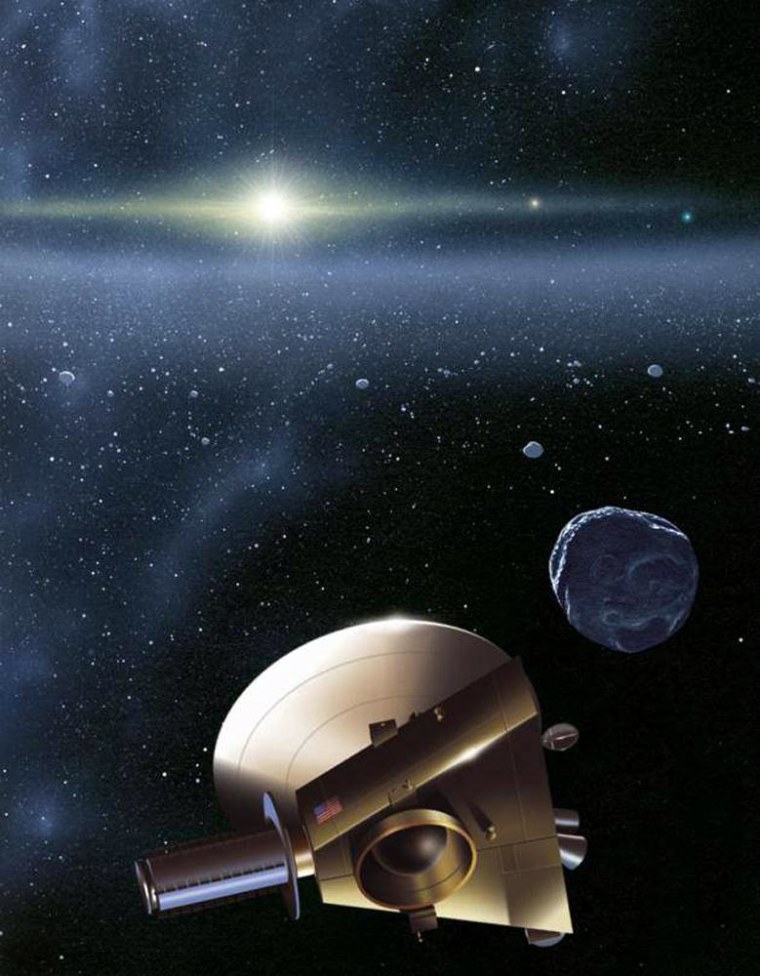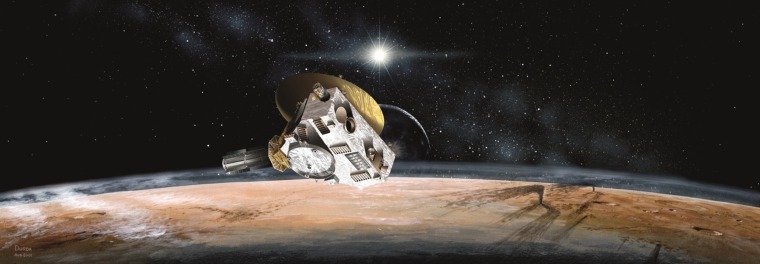NASA's New Horizons spacecraft will be working at capacity during its flyby of the dwarf planet Pluto and its moons in July 2015 — but after the flyby is finished, it'll move on to its next objectives: looking for other icy objects on the solar system's rim, and carrying messages from Earth to the stars.
The next few months will be key for laying the groundwork for New Horizons' post-Pluto projects. One piece of that groundwork is in place already, thanks to NASA's go-ahead for the New Horizons Message Initiative. Another piece will be the subject of debate in just a couple of weeks, when scientists meet to draw up the Hubble Space Telescope's to-do list.
The quest for contact
Let's start with the messages: Over the weekend, organizers of the New Horizon Message Initiative announced that NASA has agreed to upload a crowdsourced set of digital "selfies" to the spacecraft after it sends out (and flushes out) the data from the Pluto flyby.
The $650 million New Horizons mission was built on an extremely tight budget, and that means there was no room for anything addressed to extraterrestrials. There was no "Hello, We're Humans" plaque like the ones placed on the Pioneer probes; no Golden Record like the ones included on the Voyager missions.
Jon Lomberg, an artist and journalist who collaborated with the late astronomer Carl Sagan on Voyager's Golden Record, thought that was a shame. Eventually he came up with the idea of sending out a digital message file to New Horizons in flight, and sold the mission's managers on the idea.
This time, the messages will be chosen by the whole wide world, rather than an elite group of culture vultures. "It was very presumptuous of Carl Sagan and the rest of us to speak for Earth, but at the time it was either do it that way or don't do it at all," Lomberg told National Geographic.
The Message Initiative is to get under way in earnest on Aug. 25, when New Horizons is due to cross the orbit of Neptune. That day marks exactly 25 years since Voyager 2 made its own Neptune flyby, and NASA will celebrate the occasion with a "ceremonial handing of the torch" at its Washington headquarters.
Starting in August, the OneEarthMessage.org website will take in submissions of various types — images, sounds, text, computer code — and put them to a vote. Lomberg's partner on the project, crowdsourcing specialist Albert Yu-Min Lin, is working on a system to prioritize the messages and put the winning entries into a file that would be uploaded to New Horizons once the probe's computer memory is freed up.
Lomberg acknowledges there's little chance that aliens will ever find and decode the message. But the true point of the exercise is something closer to home: What are the most important things to say about life on Earth? And will identifying those things help us appreciate them more? That was certainly the case for the Golden Record, and it's likely to be the case for the New Horizon Message as well.

The search for icy objects
So when will the message be uploaded? That depends on New Horizons' post-Pluto scientific program. It could take months for the spacecraft to transmit all of its data from the Pluto flyby — and when that's finished, there's a chance that the probe will gear up for yet another encounter.
The science team wants to study at least one more object in the Kuiper Belt, the broad, sparsely populated band of icy mini-worlds that lie beyond Neptune's orbit. If the right object is found, the message upload would be delayed until after New Horizons executes its follow-up encounter.
That's OK with Lomberg: "As long as the spacecraft is healthy and the radio is working, there's no particular rush to send it before everyone's happy," he told National Geographic.
However, so far the right object hasn't turned up, even though the New Horizons team has been poring over sky surveys. The best way to look for a good candidate would be to use the Hubble Space Telescope, and that option is due to come up for consideration next month during a round of meetings at the Space Telescope Science Institute in Baltimore.
Last month, two NASA advisory panels — the Small Bodies Assessment Group and the Outer Planets Assessment Group — expressed strong support for the idea of using Hubble to search for suitable Kuiper Belt objects. Small, primitive KBOs that were "left over from the era of planet formation" would be of particular interest.
"The scientific bounty of a spacecraft encounter with a primitive KBO is realizable in our lifetimes, but only with New Horizons, and only if a suitable target can be found while there is still time to reach it," the panels wrote. "No other mission currently in flight, in build, or in design will reach the Kuiper Belt. Time is of the essence for New Horizons."
The scientists said that a target would have to be identified this year in order to leave enough time for planning New Horizons' post-Pluto trajectory. "The probability of a successful search substantially declines if postponed to 2015," they wrote.
Will NASA's New Horizons mission turn into a "twofer" — or will it be Pluto, period? Stay tuned...
